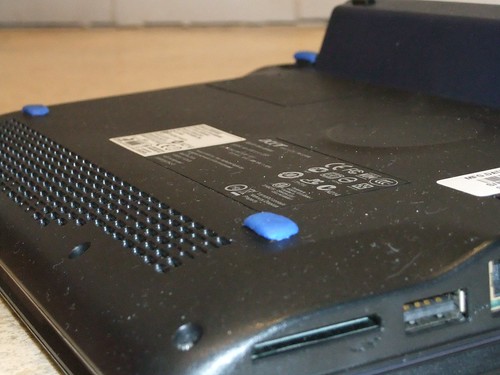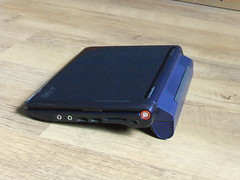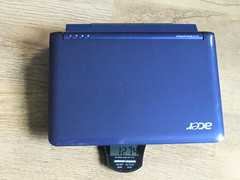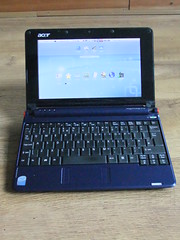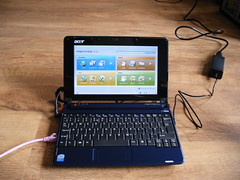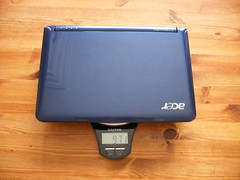Sugru is like slightly toxic plasticene when you first get it out of the box, but it sets like strong rubber. In fact it was perfect for this, the finished feet feel securely attached and they’re slightly squishy so they absorb the shock of me typing or the issues of a slightly uneven surface. Perfect!
Tag Archives: aspireone
Using gnome-keybinding-properties
 Last week I reinstalled my aspireone, which I’ve had for quite a while but which is really excellent for events. I put the latest Ubuntu Netbook Remix onto it and it installed like a dream, with peripherals and powersaving all working correctly. It says something about the positive experiences I’ve had with *buntu installs lately that I even did this over the wifi!
Last week I reinstalled my aspireone, which I’ve had for quite a while but which is really excellent for events. I put the latest Ubuntu Netbook Remix onto it and it installed like a dream, with peripherals and powersaving all working correctly. It says something about the positive experiences I’ve had with *buntu installs lately that I even did this over the wifi!
The weird thing was that I don’t really use Gnome on other machines as I prefer KDE, and I hadn’t seen the Unity desktop before (as I understand it, this is a lightweight gnome replacement – it still looks and smells like gnome to me), so there were a few things that were “missing” as far as I was concerned. Easily the most annoying is the Alt+F2 shortcut, I don’t really care what GUI I’m using, I mostly just run things from that! I also realised that I now had workspaces, but that there was no keyboard shortcut to switch between them (I don’t use a mouse, so it’s keyboard or nothing for me).
Enter a wonderful utility called gnome-keybinding-properties.
Continue reading
A “new” Netbook for Conferences
More than 512 MB RAM
I’ve now had the machine more than 18 months and I’ve been using it for events and keeping it by the bed pretty much ever since. However this year I’m speaking at TEK-X in Chicago and found myself wondering if I should get a new little machine to take with me. A few months back I upgraded the RAM in the machine (it had 512 MB originally!), and I came to the conclusion that actually, I didn’t need to splash out for a new netbook since with a bit more memory, its pretty usable.
Bigger Battery Life
Instead of replacing the machine, I bought the extended battery for the aspireone, taking me from about 2 hours to about 6 (I think, haven’t tried this battery life in anger yet). Its chunky, but not offensive:
It is quite a bit heavier than the old one – my original post about getting the aspireone weighed it with its original battery at 971g and with the extended battery, its 1274g, which is still only half the weight of my current work laptop.
Kubuntu Netbook Edition
Reading back to that original post about the netbook it was pretty obvious that I was hating that operating system. A couple of years ago, the support for aspireone in Ubuntu Netbook Remix became usable, and I installed that. Its been fabulous and I had no intention to do anything more than upgrade … until someone at OggCamp showed me they had the Kubuntu Netbook edition on their netbook.
It is shiny and blue, and since I use KDE on my laptop I couldn’t resist and I upgraded it with a week to go before I take it as my only machine as a speaker at a conference!
In Summary
I haven’t spent a lot of money on the upgrades, the battery was about 50 GBP and the RAM came out of something else. I did have a large capacity SD card in the expansion slot since I only have 8GB hard drive. Then there was a problem with the machine suspending with the expansion slot in use and at around the same time I got a camera that takes SD … so I put my big card into there instead :) I don’t keep data on the netbook so its not an issue for me. I’ll be flying to Chicago for Tek in a few days, and presenting off my netbook as usual. For a budget machine with a little bit of love and attention added in, “Merry” (short for Merope) the netbook has been quite a fabulous investment!
Ubuntu Netbook Remix on Aspire One
The way this works is that on another machine (or I guess on an existing OS on the netbook) you download a bootable USB key image. With some trepidation (not a whole lot, I did back up first), I put in the USB key and settled in to see how far I could get with the installation.
Well, a short time later I realised I’d finished installing and was really just fiddling! Straight out of the box the wifi worked, the hibernate worked, sound (in and out) worked, the webcam worked, and there is this great window handler thing which amalgamates title bar and task bar into one. There’s also a cute menu on the desktop – all in all its really neat:
The working hibernate in particular has really made a big difference, at home the netbook just gets used for short bursts and lives next to my bed, usually plugged in. When it comes into its own though is at conferences! I can flip this thing open, use it, and flip it shut, pretty much all day. The startup time is really small from suspend and so long as I’m only dipping in and out (at conferences, I’m mostly in talks so I’m only ever checking mail etc), the battery life easily lasts a day.
Thanks to the Ubuntu folks – this is one quality piece of software and now I love my little netbook even more. Anyone else using the netbook remix? Were your experiences as good as mine?
Presenting with a Netbook
The netbook is easily up to this job – it happily runs the open office presenter program, I don’t have the presenter view plugin installed on it yet but just use the screens mirrored and use the netbook screen to see the current slide rather than having to look at the screen. This saves me either having to look away from my audience or from being completely floored by slides WAY too big for me to read when I’m standing in front of them (I presented at the FOWA roadshow, great venue but slides so big I didn’t dare look round at them!). The netbook screen is small but font sizes on slides should be quite big and I’m kind of long sighted so I can read the text at a distance of 6 to 8 feet without an issue.
The presenter mouse has a little USB dongle and then controls for controlling the presentation, with a laser pointer and a button to turn slides to black – once I begin I don’t need to be back within reach of the computer at any point. Which is really useful if you get one of those awkward spaces where the dock for the laptop is in a corner you don’t want to be standing in (I see this a lot at the informal geek events). Just start it going and get into position – and present from there. Of course this relies on knowing the presentation well enough to not need your slides or notes or having a paper copy you can refer to.
Don’t be fooled that you need great hardware or particular equipment to give a talk – anything with a monitor socket to talk to the projector is good enough, and if you can get a remote of some kind then all the better. Other accessories that might help is a stop watch (or use the timer on your phone and put it somewhere you can see it), so you know how you are doing for time, and some notes on index cards that you can easily hold without rustling. Above all, take a step away from your computer and look your audience in the eye – they’re here to see and hear you.
Acer Aspire One (and cosy)
The hardware isn’t the best in its class, but it isn’t the most expensive machine either. It has 512MB RAM, 8GB hard drive (solid state drive), it measures 8.9 inches and weighs just 971g.
The default OS for the linux version is something called “Linpus Lite”, which is a kind of toddler fedora as far as I can tell. I’m a long-term linux user and I found the locked-down-ness and the limited interface quite difficult to get started with. However with some help from this nice walkthrough plus some tips from the aspireoneuser.com forums I managed to get root access, turn on the xfce right-click menu and add a menu to the panel, install Opera and Skype and customise the main menu screens. Oh and have multiple desktops, which I like.
Its great for reading feeds, email, chat, and so on, and that’s probably all I’ll use it for. Since I often develop on a dev machine over vim + ssh, I might develop from this machine but I don’t think I’ll develop on it very often. I have already been tripped up by not having particular programs and not knowing what to use instead. Konqueror is leaving a big gap in my life, I do use it a lot. I haven’t done much with fedora before, I’m sure yum is great but it isn’t aptitude. Also the weird “the default user logs in automatically, needs no password, and has instant sudo rights” setup makes me twitch. We tried turning off the sudo rights but bits of the desktop stopped showing up so I’ve left that as is.
There are some definite disappointments. The multi card reader claims to read XD cards – this is a big selling point for me as I have reason to be on the road with camera and laptop soon and I have a fujipix camera which takes an XD card. Well, XD cards do not work with the acer aspire ones so far as I can tell. We’ve dug through the drivers and it looks like it just isn’t set up to do it at all. I’m logged a support email with Acer but no response just yet. I bought the machine through PC World which seems to reduce the amount of support Acer gives, which is a bit disappointing as I didn’t know that before I did it (nobody else seemed to have supply, and they are local if entirely unfriendly. I know I don’t look like a proper geeky business user, but that doesn’t mean you can ignore or patronise me). The wireless won’t resume if it was turned on and the machine hibernates, you have to turn off the wireless before you do that, which seems like a little niggle but when you have lots of tabs active and you have to reboot to get your connection back … its really annoying.
All in all, I would usually have waited for a second generation machine but this is cute, it seems pretty robust, and withouth being very expensive it does everything I need. And at less than 1 kg, I can actually carry it without getting shorter in the process, which is more than I can say for my laptop! There is online evidence of people successfully getting proper ubuntu installations onto these machines and I’m very tempted by that idea.
I have been busy installing the new toy, but I have also been busy making it a cosy!
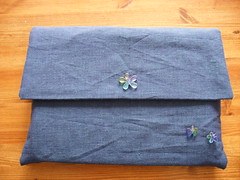
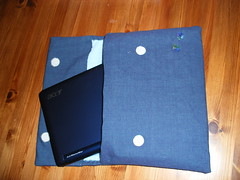
Its canvas on the outside, microfibre cloth on the inside (its really shiny and gets fingerprint-y, its good to have the soft inside) and it has rigid panels (made from a plastic placemat that got too close to me while I was feeling inspired). I made two simple envelope-type bags, put them inside one another, and stitched the lining into the outer. The fastenings are sticky dots of velcro (which I shoudl have sewn in because it doesn’t stick well to fabric, oops), and the beads are ones I’ve had in my stash for … more than ten years, scarily enough. They were just waiting for this project! I made the case to be a loose fit, knowing that I’ll try to get A5 paper in there as well as the machine itself as its sort of a convenient size!

